Hello, fellow lovers of all things green. It was April Fool’s Day when I entered Willowwood Arboretum. The meadows had not yet emerged but were dancing with daffodils. I made my way to the parking lot, where Bruce Crawford, Morris County Park Commission’s Manager of Horticulture, greeted me to give a grand tour of the many wonders of Willowwood Arboretum.
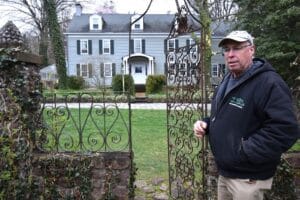
Bruce Crawford, Manager of Horticulture, Morris County Park Commission

The Cottage Garden at Willowwood Arboretum in Early Spring
“When you visit Willowwood, you feel like you’re visiting someone’s at home.”
And you are. Located in Chester Township, NJ, it was the country residence of brothers Henry and Robert Tubbs, who purchased the property in 1908. Both were garden enthusiasts who went far and wide to gather plants.
What joy to see the early spring colors. Bruce described how the carpet of yellow of Winter Aconite transformed into a carpet of purples and blue of Siberian Squill and Grape Hyacinth.
The Wonders of Willowwood
“What’s fun for people who come is what you see is not five years of growth but nearly 100 years of growth. Some of the bulbs you see have self-seeded; it would be impossible to plant that many.”
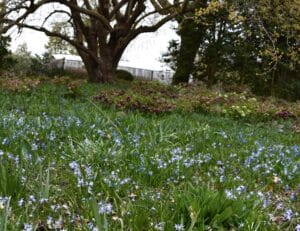
Siberian Squill (Scilla siberica)
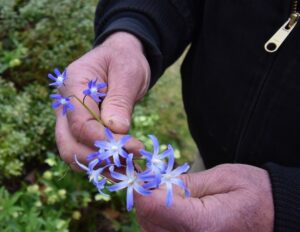 Scilla siberica (Siberian Squill) is a compact dwarf plant with spikes of sky-blue blooms that is stunning in lawns, naturalizing easily, and lovely edging in mixed borders.
Scilla siberica (Siberian Squill) is a compact dwarf plant with spikes of sky-blue blooms that is stunning in lawns, naturalizing easily, and lovely edging in mixed borders.
Bruce shared a nifty gardening tip. They planted 2,000 Scilla bulbs in lawn areas in the Fall by merely lifting the sod, putting in the bulbs, and placing the sod back – easy peasy. What a clever way to help our pollinators in early spring.
I asked when they’d mow the lawn, knowing the plants must photosynthesize before going dormant. And they don’t mow until the end of May—music to my ears. I love the benefits of No Mow May to help pollinators.
Newfound admiration for Grape Hyacinth
I’m not a fan of Grape Hyacinth, and Bruce admitted he once wasn’t either. “It’s quite formal,” but Bruce shared how the flower has a fascinating twirl that blends beautifully amongst other plants, making them less formal. Its clusters of tiny, cobalt-blue bell-shaped flowers resemble upside-down grapes, hence the common name. I now have a new appreciation for Muscari armeniacum. There’s a life lesson in that.
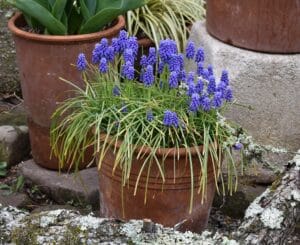
Grape hyacinth (Muscari armeniacum),
Twinleaf (Jeffersonia diphylla) is a native woodland plant. Bruce coined it “Lung Plant” because it looks like a dainty set of lungs that grows 12 to 18 inches and has white star-like flowers.
“There’s only one other species, native to Asia. Somehow, when the world split, it ended up here, which I find fascinating.” It likes part shade and thrives in moist woodlands, including mine. How fun to now know its name.
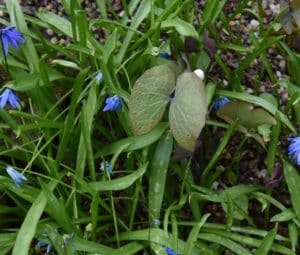
Twinleaf (Jeffersonia diphylla). Bruce coined it “Lung Plant.”
Aging is beautiful
Among my favorite plants observed the day were the old trees, some in drastic decline. I admire how they allow them to stay standing.
There’s a half-dead Yew (Taxus) in the front they decorated with Tillandsia last year. Air Plants have become trendy household plants. They are epiphytes in nature, meaning their roots function only as an attachment to other plants or rocks for support. Their leaves have a structure called Trichomes that trap moisture and dust for nourishment.
This year, they plan to dress the old Yew with orchids, embracing the beauty of the plants’ last years. There is beauty in aging; the changes reflect lives well-lived. It’s true of plants and people.
Willowwood’s 100-year-old ‘Waterfall’ Japanese Maple (Acer palmatum var. dissectum) was strategically pruned in its early years, revealing the trunk and branching like a sculpture. I adore how it cascades like a waterfall with lace-like, lustrous green leaves that turn a stunning golden color with streaks of orange and red in the Fall. The tree, which thrives in moist soil, has been handling flooding in the garden area that began in recent years because of the new developments surrounding Willowwood. It just goes to show that when you develop a strong structure, resilience endures. The same is true for us.
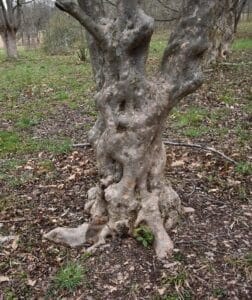
“When it’s young, Kousa doesn’t have nearly the character.”
Kousa Dogwood gains character as it grows.
I admired a Kornus Dogwood planted almost 80 years ago. Cornus Kousa displays white cartoon-like four-inch flowers of happiness in late spring.
“When it’s young, Kousa doesn’t have nearly the character,” Bruce said.
As it ages, the trunk transforms to have gorgeously patchy brownish-grey bark. Willowwood’s specimen has extra bumps and lumps on the trunk. Sound familiar (smile)?
“It’s where old branches healed over.” Indeed, scars are badges of growth as we age, and growth is a beautiful thing.

“It’s the only tree I know with armpits.”
“The only tree I know with armpits.”
Willowwood’s enormous Dawn Redwood (Metasequoia glyptostroboides) is a National Champion Tree. Bruce gave a captivating history of how Dawn Redwood Survived.
“It’s the only tree I know with armpits.” Bruce points to where the branches connect to the trunk. I adored learning that the observation came from Bruce Hamilton, a legendary Plant Science instructor who taught at Rutgers University.
Bruce gave a captivating history of how Dawn Redwood Survived.
“Fossils were found in Germany’s east coast, North America, Japan, and China. It wasn’t until World War II that they found it in a valley in China. And so the National Arboretum, and the Arnold Arboretum went over in 1947 and got seeds. This tree was part of the original reintroduction. Seventy million years ago, this was your predominant tree species. And it almost went extinct.”
Proof there is hope we can turn things around.
Thank you, Bruce. Your knowledge is immense, and you share it so graciously. Those privileged to know you catch a bit of your self-proclaimed plant geekiness. It’s a glorious gift.
Garden Dilemmas? AskMaryStone@gmail.com and your favorite Podcast App.
There is more to the story in the Garden Dilemmas Podcast (a soothing 10 minutes):
Related stories and Podcasts you’ll enjoy:
Wandering Willowwood Arboretum — blog post
Episode 34. Forest Bathing, Willowwood Champion Trees
No Mow May Helps Pollinators -blog post
Episode 103. No Mow May & Marvelous Moss
Link to Willowwood Arboretum


